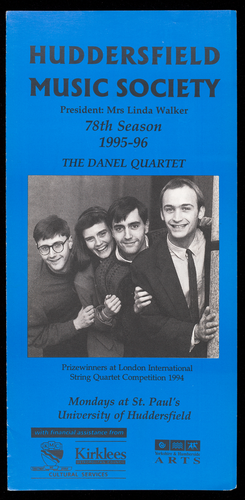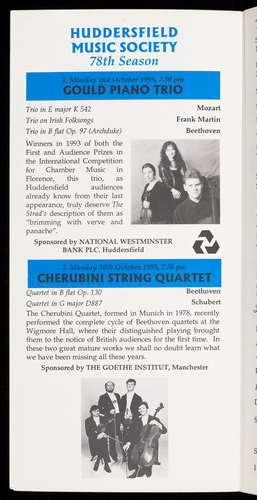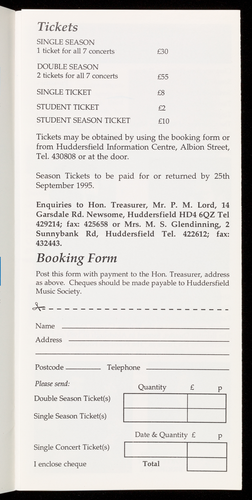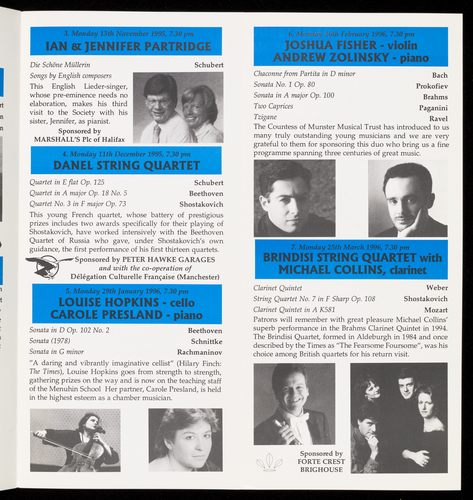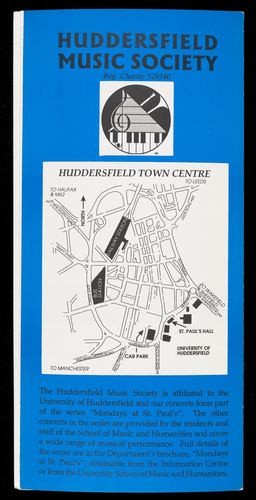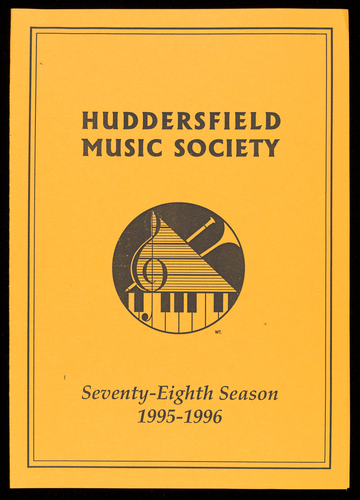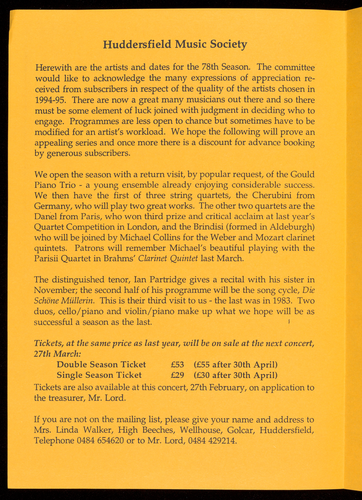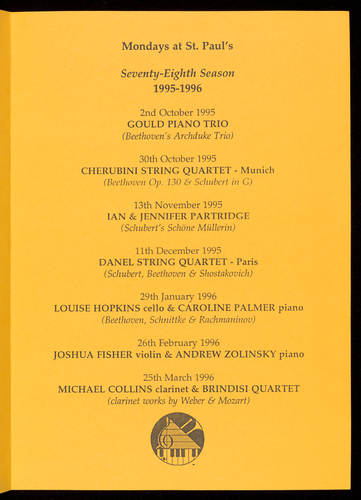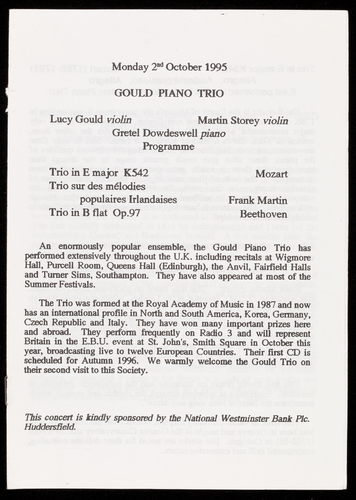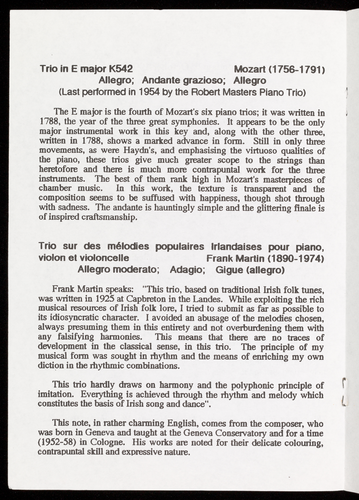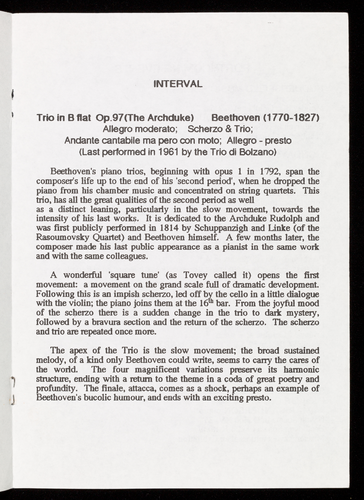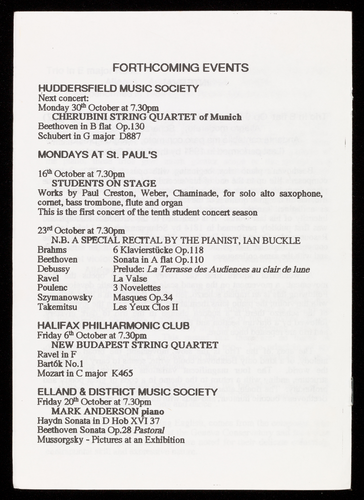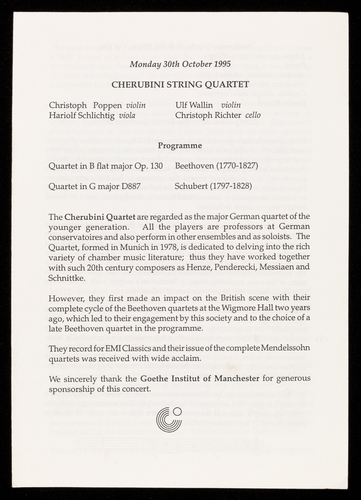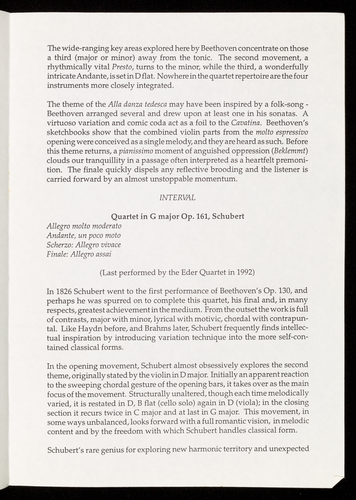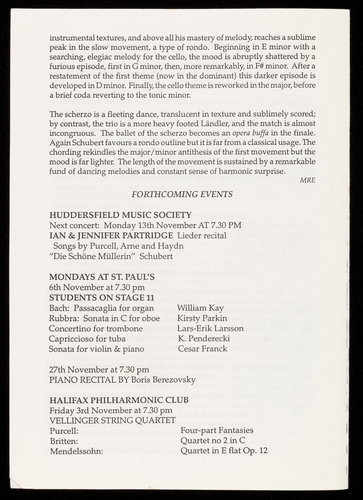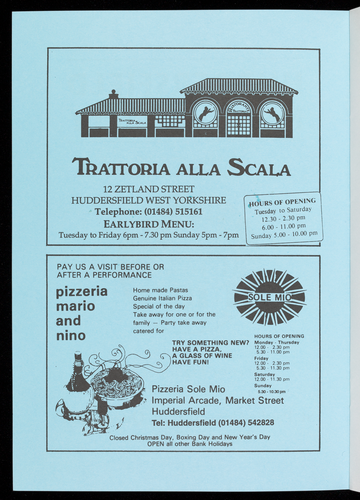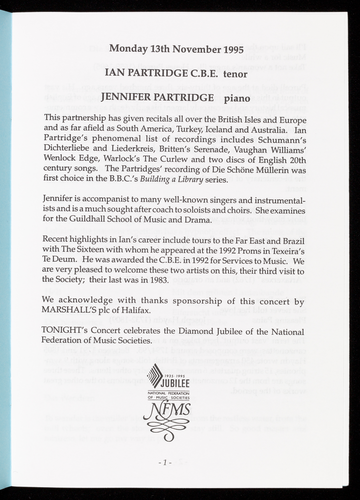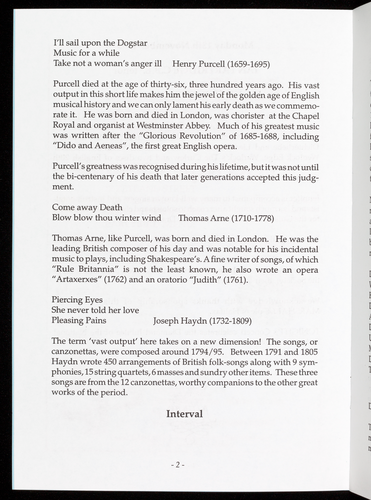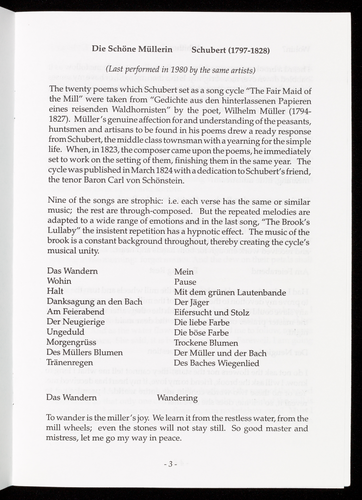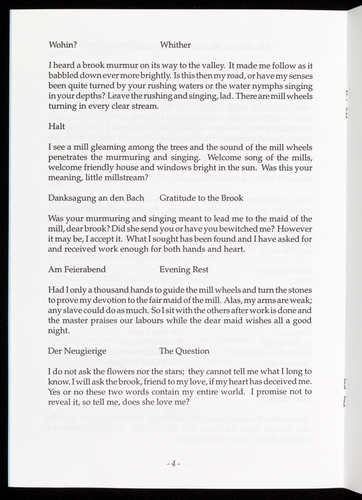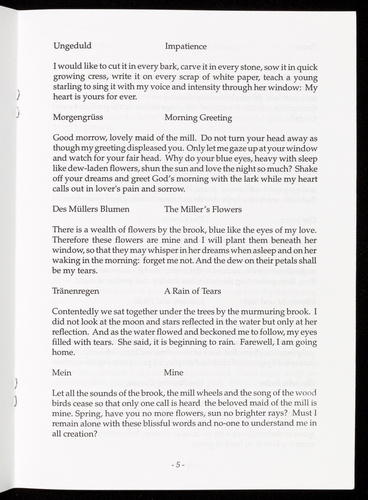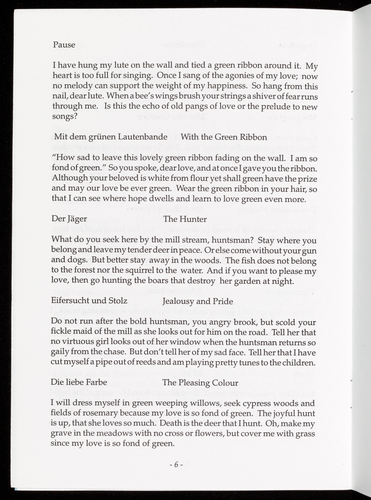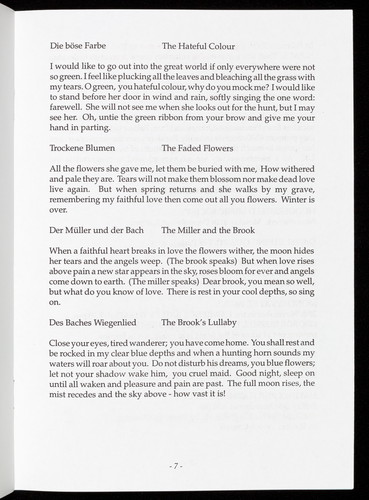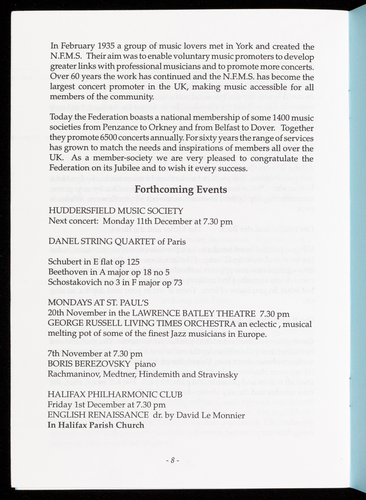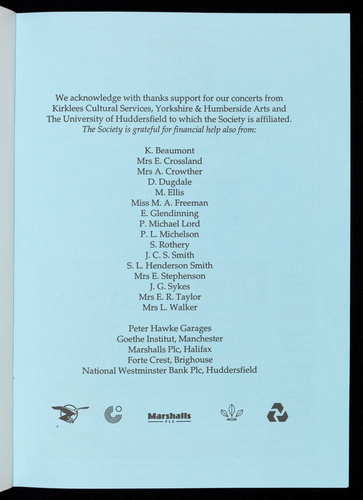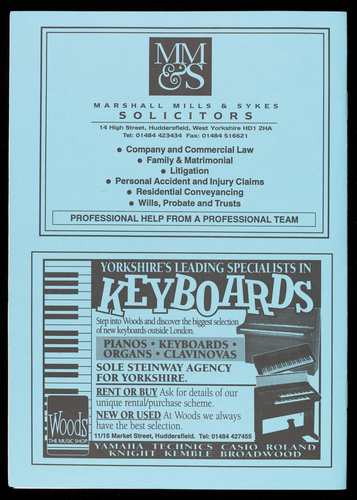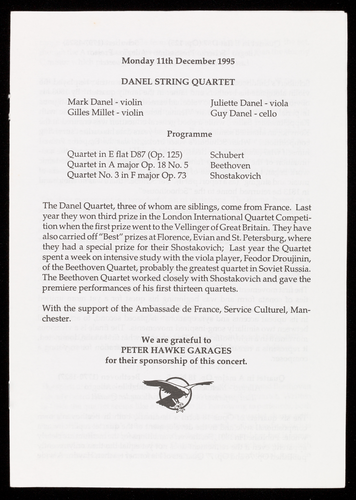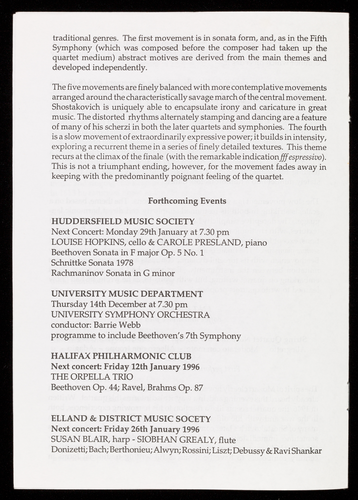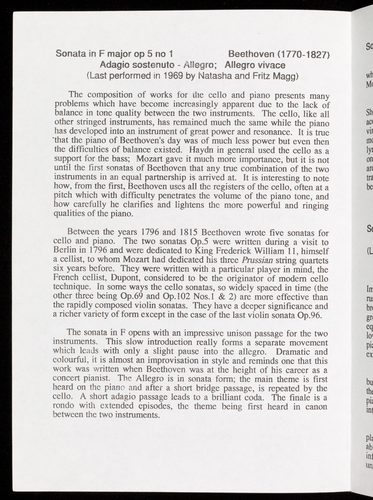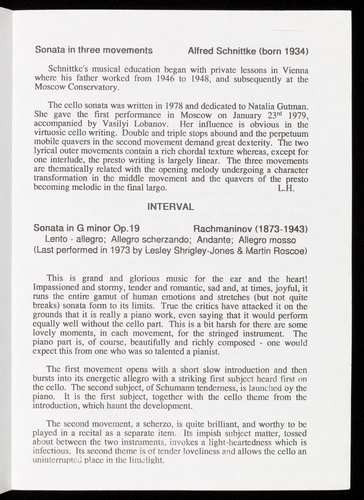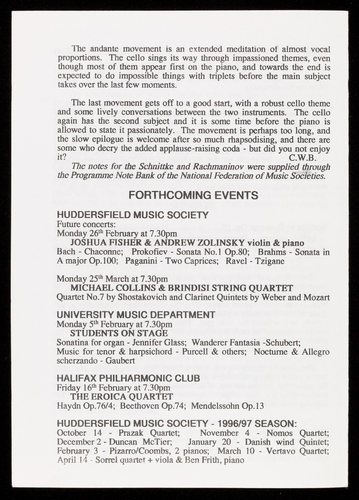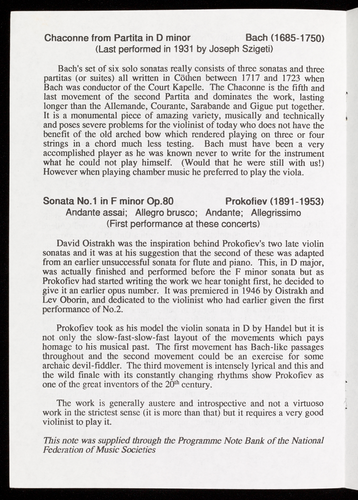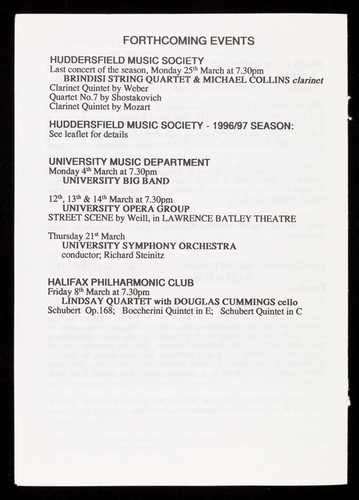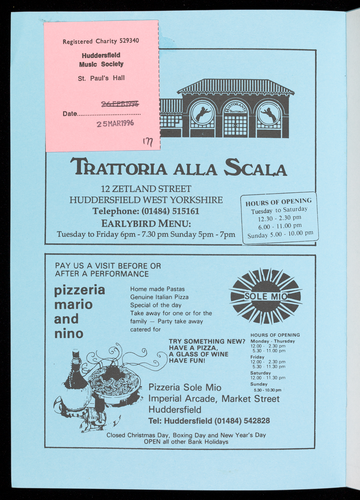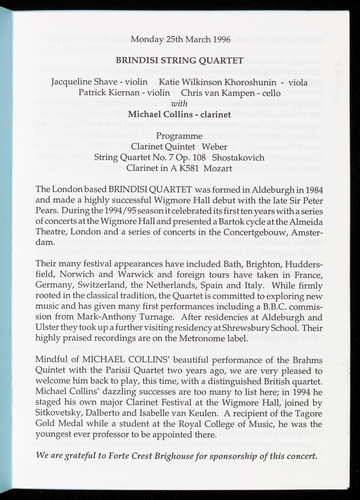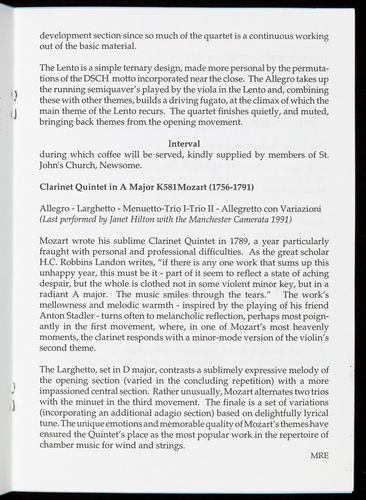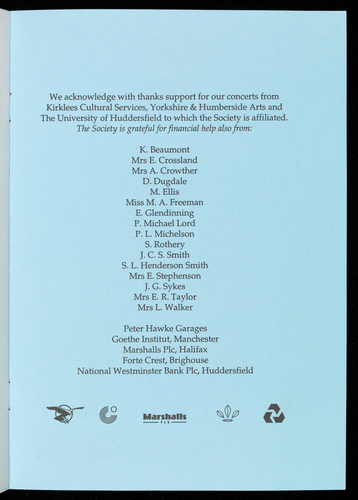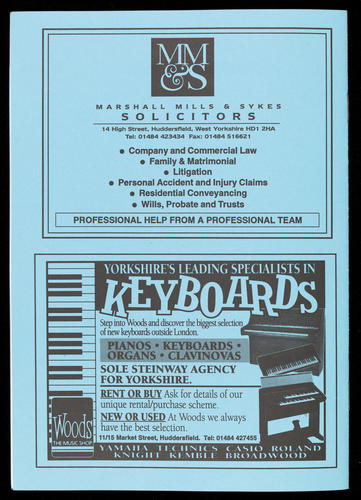Ocr'd Text:
HUDDERSFIELD
MUSIC SOCIETY
President: Mrs Linda Walker
78th Season
1995-96
THE DANEL QUARTET
TOGETHER
with financial assistance from
KMC
WE
a
Prizewinners at London International
String Quartet Competition 1994
Mondays at St. Paul's
University of Huddersfield
Kirklees
METROPOLITAN COUNCIL
SEAVE
CULTURAL SERVICES
*
Yorkshire & Humberside
ARTS
Ocr'd Text:
HUDDERSFIELD
MUSIC SOCIETY
78th Season
1. Monday 2nd October 1995, 7.30 pm
GOULD PIANO TRIO
Trio in E major K 542
Trio on Irish Folksongs
Trio in B flat Op. 97 (Archduke)
Winners in 1993 of both the
First and Audience Prizes in
the International Competition
for Chamber Music in
Florence, this trio, as
Huddersfield
audiences
already know from their last
appearance, truly deserve The
Strad's description of them as
"brimming with verve and
panache".
Sponsored by NATIONAL WESTMINSTER
BANK PLC. Huddersfield
Mozart
Frank Martin
Beethoven
2. Monday 30th October 1995, 7.30 pm
CHERUBINI STRING QUARTET
Quartet in B flat Op. 130
Beethoven
Quartet in G major D887
Schubert
The Cherubini Quartet, formed in Munich in 1978, recently
performed the complete cycle of Beethoven quartets at the
Wigmore Hall, where their distinguished playing brought
them to the notice of British audiences for the first time. In
these two great mature works we shall no doubt learn what
we have been missing all these years.
Sponsored by THE GOETHE INSTITUT, Manchester
S
I
Ocr'd Text:
Tickets
SINGLE SEASON
1 ticket for all 7 concerts
DOUBLE SEASON
2 tickets for all 7 concerts
SINGLE TICKET
STUDENT TICKET
STUDENT SEASON TICKET
Tickets may be obtained by using the booking form or
from Huddersfield Information Centre, Albion Street,
Tel. 430808 or at the door.
Name
Address
£30
Season Tickets to be paid for or returned by 25th
September 1995.
Postcode
£55
Enquiries to Hon. Treasurer, Mr. P. M. Lord, 14
Garsdale Rd. Newsome, Huddersfield HD4 6QZ Tel
429214; fax: 425658 or Mrs. M. S. Glendinning, 2
Sunnybank Rd, Huddersfield Tel. 422612; fax:
432443.
Telephone
£8
Booking Form
Post this form with payment to the Hon. Treasurer, address
as above. Cheques should be made payable to Huddersfield
Music Society.
&
Please send:
Double Season Ticket(s)
Single Season Ticket(s)
£2
£10
Single Concert Ticket(s)
I enclose cheque
Quantity
£
Date & Quantity £
Total
P
р
Ocr'd Text:
rt
n
n
n
t
1
3. Monday 13th November 1995, 7.30 pm
IAN & JENNIFER PARTRIDGE
Die Schöne Müllerin
Songs by English composers
This English Lieder-singer,
whose pre-eminence needs no
elaboration, makes his third
visit to the Society with his
sister, Jennifer, as pianist.
Sponsored by
MARSHALL'S Plc of Halifax
Schubert
4. Monday 11th December 1995, 7.30 pm
DANEL STRING QUARTET
Quartet in E flat Op. 125
Schubert
Quartet in A major Op. 18 No. 5
Beethoven
Quartet No. 3 in F major Op. 73
Shostakovich
This young French quartet, whose battery of prestigious
prizes includes two awards specifically for their playing of
Shostakovich, have worked intensively with the Beethoven
Quartet of Russia who gave, under Shostakovich's own
guidance, the first performance of his first thirteen quartets.
Sponsored by PETER HAWKE GARAGES
and with the co-operation of
Délégation Culturelle Française (Manchester)
5. Monday 29th January 1996, 7.30 pm
LOUISE HOPKINS- cello
CAROLE PRESLAND - piano
Sonata in D Op. 102 No. 2
Sonata (1978)
Sonata in G minor
Beethoven
Schnittke
Rachmaninov
“A daring and vibrantly imaginative cellist" (Hilary Finch:
The Times), Louise Hopkins goes from strength to strength,
gathering prizes on the way and is now on the teaching staff
of the Menuhin School Her partner, Carole Presland, is held
in the highest esteem as a chamber musician.
6. Monday 26th February 1996, 7.30 pm
JOSHUA FISHER - violin
ANDREW ZOLINSKY - piano
Chaconne from Partita in D minor
Sonata No. 1 Op. 80
Sonata in A major Op. 100
Two Caprices
Bach
Prokofiev
Brahms
Paganini
Tzigane
Ravel
The Countess of Munster Musical Trust has introduced to us
many truly outstanding young musicians and we are very
grateful to them for sponsoring this duo who bring us a fine
programme spanning three centuries of great music.
7. Monday 25th March 1996, 7.30 pm
BRINDISI STRING QUARTET with
MICHAEL COLLINS, clarinet
Clarinet Quintet
String Quartet No. 7 in F Sharp Op. 108
Clarinet Quintet in A K581
Mozart
Patrons will remember with great pleasure Michael Collins'
superb performance in the Brahms Clarinet Quintet in 1994.
The Brindisi Quartet, formed in Aldeburgh in 1984 and once
described by the Times as "The Fearsome Foursome", was his
choice among British quartets for his return visit.
le
Sponsored by
FORTE CREST
BRIGHOUSE
D
Weber
Shostakovich
Ocr'd Text:
A629
HUDDERSFIELD
MUSIC SOCIETY
Reg. Charity 529340
TO HALIFAX
& M62
NEW NORTH ROADO
TRINITY STREET
HUDDERSFIELD TOWN CENTRE
TO LEEDS
NORTH
7
CASTLE GATE
STATION
BUS
(O
TO MANCHESTER
II
A62 MANCHESTER ROAD
RAILWAY STATION
1009
2009
鍋
00G00
A616 CHAPEL HILL
WT.
200
00
001
DA
QUEESINGATE
1
CAR PARK
QUEESN ST SOUTH
SOUTHGATE
QUEENS
LEEDS ROAD A62
TO WAKEFIELD
& SHEFFIELD
A629 WAKEFIELD ROAD
ST. PAUL'S HALL
UNIVERSITY OF
HUDDERSFIELD
The Huddersfield Music Society is affiliated to the
University of Huddersfield and our concerts form part
of the series "Mondays at St. Paul's". The other
concerts in the series are provided by the students and
staff of the School of Music and Humanities and cover
a wide range of musical performance. Full details of
the series are in the Department's brochure, "Mondays
at St. Paul's", obtainable from the Information Centre
or from the University School of Music and Humanities.
Ocr'd Text:
HUDDERSFIELD
MUSIC SOCIETY
WT.
Seventy-Eighth Season
1995-1996
Ocr'd Text:
Huddersfield Music Society
Herewith are the artists and dates for the 78th Season. The committee
would like to acknowledge the many expressions of appreciation re-
ceived from subscribers in respect of the quality of the artists chosen in
1994-95. There are now a great many musicians out there and so there
must be some element of luck joined with judgment in deciding who to
engage. Programmes are less open to chance but sometimes have to be
modified for an artist's workload. We hope the following will prove an
appealing series and once more there is a discount for advance booking
by generous subscribers.
We open the season with a return visit, by popular request, of the Gould
Piano Trio - a young ensemble already enjoying considerable success.
We then have the first of three string quartets, the Cherubini from
Germany, who will play two great works. The other two quartets are the
Danel from Paris, who won third prize and critical acclaim at last year's
Quartet Competition in London, and the Brindisi (formed in Aldeburgh)
who will be joined by Michael Collins for the Weber and Mozart clarinet
quintets. Patrons will remember Michael's beautiful playing with the
Parisii Quartet in Brahms' Clarinet Quintet last March.
The distinguished tenor, Ian Partridge gives a recital with his sister in
November; the second half of his programme will be the song cycle, Die
Schöne Müllerin. This is their third visit to us - the last was in 1983. Two
duos, cello/piano and violin/piano make up what we hope will be as
successful a season as the last.
Tickets, at the same price as last year, will be on sale at the next concert,
27th March:
£53 (£55 after 30th April)
£29 (£30 after 30th April)
Double Season Ticket
Single Season Ticket
Tickets are also available at this concert, 27th February, on application to
the treasurer, Mr. Lord.
If you are not on the mailing list, please give your name and address to
Mrs. Linda Walker, High Beeches, Wellhouse, Golcar, Huddersfield,
Telephone 0484 654620 or to Mr. Lord, 0484 429214.
Ocr'd Text:
Mondays at St. Paul's
Seventy-Eighth Season
1995-1996
2nd October 1995
GOULD PIANO TRIO
(Beethoven's Archduke Trio)
30th October 1995
CHERUBINI STRING QUARTET - Munich
(Beethoven Op. 130 & Schubert in G)
13th November 1995
IAN & JENNIFER PARTRIDGE
(Schubert's Schöne Müllerin)
11th December 1995
DANEL STRING QUARTET - Paris
(Schubert, Beethoven & Shostakovich)
29th January 1996
LOUISE HOPKINS cello & CAROLINE PALMER piano
(Beethoven, Schnittke & Rachmaninov)
26th February 1996
JOSHUA FISHER violin & ANDREW ZOLINSKY piano
25th March 1996
MICHAEL COLLINS clarinet & BRINDISI QUARTET
(clarinet works by Weber & Mozart)
WT.
Ocr'd Text:
(TOTI-8351) has Monday 2nd October 1995
GOULD PIANO TRIO
yao Lucy Gould violin
Gretel Dowdeswell piano
Programme
Trio in E major K542
Trio sur des mélodies
populaires Irlandaises
Martin Storey violin
Trio in B flat Op.97
Mozart
Frank Martin
Beethoven
An enormously popular ensemble, the Gould Piano Trio has
performed extensively throughout the U.K. including recitals at Wigmore
Hall, Purcell Room, Queens Hall (Edinburgh), the Anvil, Fairfield Halls
and Turner Sims, Southampton. They have also appeared at most of the
Summer Festivals.
The Trio was formed at the Royal Academy of Music in 1987 and now
has an international profile in North and South America, Korea, Germany,
Czech Republic and Italy. They have won many important prizes here
and abroad. They perform frequently on Radio 3 and will represent
Britain in the E.B.U. event at St. John's, Smith Square in October this
year, broadcasting live to twelve European Countries. Their first CD is
scheduled for Autumn 1996. We warmly welcome the Gould Trio on
their second visit to this Society.
This concert is kindly sponsored by the National Westminster Bank Plc.
Huddersfield.
Ocr'd Text:
Trio in E major K542
Mozart (1756-1791)
Allegro; Andante grazioso; Allegro
(Last performed in 1954 by the Robert Masters Piano Trio)
The E major is the fourth of Mozart's six piano trios; it was written in
1788, the year of the three great symphonies. It appears to be the only
major instrumental work in this key and, along with the other three,
written in 1788, shows a marked advance in form. Still in only three
movements, as were Haydn's, and emphasising the virtuoso qualities of
the piano, these trios give much greater scope to the strings than
heretofore and there is much more contrapuntal work for the three
instruments. The best of them rank high in Mozart's masterpieces of
chamber music. In this work, the texture is transparent and the
composition seems to be suffused with happiness, though shot through
with sadness. The andante is hauntingly simple and the glittering finale is
of inspired craftsmanship.
Trio sur des mélodies populaires Irlandaises pour piano,
violon et violoncelle
Frank Martin (1890-1974)
Allegro moderato; Adagio; Gigue (allegro)
Frank Martin speaks: "This trio, based on traditional Irish folk tunes,
was written in 1925 at Capbreton in the Landes. While exploiting the rich
musical resources of Irish folk lore, I tried to submit as far as possible to
its idiosyncratic character. I avoided an abusage of the melodies chosen,
always presuming them in this entirety and not overburdening them with
any falsifying harmonies. This means that there are no traces of
development in the classical sense, in this trio. The principle of my
musical form was sought in rhythm and the means of enriching my own
diction in the rhythmic combinations.
This trio hardly draws on harmony and the polyphonic principle of
imitation. Everything is achieved through the rhythm and melody which
constitutes the basis of Irish song and dance".
This note, in rather charming English, comes from the composer, who
was born in Geneva and taught at the Geneva Conservatory and for a time
(1952-58) in Cologne. His works are noted for their delicate colouring,
contrapuntal skill and expressive nature.
U
Ocr'd Text:
J
INTERVAL
Trio in B flat Op.97(The Archduke) Beethoven (1770-1827)
Allegro moderato; Scherzo & Trio;
Andante cantabile ma pero con moto; Allegro - presto
(Last performed in 1961 by the Trio di Bolzano)
Beethoven's piano trios, beginning with opus 1 in 1792, span the
composer's life up to the end of his 'second period', when he dropped the
piano from his chamber music and concentrated on string quartets. This
trio, has all the great qualities of the second period as well
as a distinct leaning, particularly in the slow movement, towards the
intensity of his last works. It is dedicated to the Archduke Rudolph and
was first publicly performed in 1814 by Schuppanzigh and Linke (of the
Rasoumovsky Quartet) and Beethoven himself. A few months later, the
composer made his last public appearance as a pianist in the same work
and with the same colleagues.
A wonderful 'square tune' (as Tovey called it) opens the first
movement: a movement on the grand scale full of dramatic development.
Following this is an impish scherzo, led off by the cello in a little dialogue
with the violin; the piano joins them at the 16th bar. From the joyful mood
of the scherzo there is a sudden change in the trio to dark mystery,
followed by a bravura section and the return of the scherzo. The scherzo
and trio are repeated once more.
The apex of the Trio is the slow movement; the broad sustained
melody, of a kind only Beethoven could write, seems to carry the cares of
the world. The four magnificent variations preserve its harmonic
structure, ending with a return to the theme in a coda of great poetry and
profundity. The finale, attacca, comes as a shock, perhaps an example of
Beethoven's bucolic humour, and ends with an exciting presto.
Ocr'd Text:
Trio in E maio FORTHCOMING EVENTS
HUDDERSFIELD MUSIC SOCIETY
Next concert:
Monday 30th October at 7.30pm
CHERUBINI STRING QUARTET of Munich
Beethoven in B flat Op.130
Schubert in G major D887
MONDAYS AT St. PAUL'S
16th October at 7.30pm
STUDENTS ON STAGE
Works by Paul Creston, Weber, Chaminade, for solo alto saxophone,
cornet, bass trombone, flute and organ
This is the first concert of the tenth student concert season
23rd October at 7.30pm
N.B. A SPECIAL RECITAL BY THE PIANIST, IAN BUCKLE
6 Klavierstücke Op.118
Sonata in A flat Op.110
Prelude: La Terrasse des Audiences au clair de lune
Brahms
Beethoven
Debussy
Ravel
Poulenc
Szymanowsky
Takemitsu
La Valse
3 Novelettes
Masques Op.34
Les Yeux Clos II
HALIFAX PHILHARMONIC CLUB
Friday 6th October at 7.30pm
NEW BUDAPEST STRING QUARTET
Ravel in F
Bartók No.1
Mozart in C major K465
ELLAND & DISTRICT MUSIC SOCIETY
Friday 20th October at 7.30pm
MARK ANDERSON piano
Haydn Sonata in D Hob XVI 37
Beethoven Sonata Op.28 Pastoral
Mussorgsky - Pictures at an Exhibition
Ocr'd Text:
Monday 30th October 1995
CHERUBINI STRING QUARTET
Christoph Poppen violin
Hariolf Schlichtig viola
Ulf Wallin violin
Christoph Richter cello
Programme
Quartet in B flat major Op. 130
Quartet in G major D887
Beethoven (1770-1827)
Schubert (1797-1828)
The Cherubini Quartet are regarded as the major German quartet of the
younger generation. All the players are professors at German
conservatoires and also perform in other ensembles and as soloists. The
Quartet, formed in Munich in 1978, is dedicated to delving into the rich
variety of chamber music literature; thus they have worked together
with such 20th century composers as Henze, Penderecki, Messiaen and
Schnittke.
However, they first made an impact on the British scene with their
complete cycle of the Beethoven quartets at the Wigmore Hall two years
ago, which led to their engagement by this society and to the choice of a
late Beethoven quartet in the programme.
They record for EMI Classics and their issue of the complete Mendelssohn
quartets was received with wide acclaim.
We sincerely thank the Goethe Institut of Manchester for generous
sponsorship of this concert.
C
Ocr'd Text:
Beethoven Quartet in B flat Major, Op 130.
Adagio, ma non troppo - Allegro
Presto
Andante con moto, ma non troppo
Alla danza tedesca: Allegro assai
Cavatina: Adagio molto espressivo
Finale: Allegro
(Last performed by the Bartok Quartet in 1977)
Beethoven's five late quartets, from the years 1823-6, radiate a sense of "other-
worldliness". As Thomas Mann wrote, 'in these masterpieces, subjectivity
and convention are brought into a new balance, one determined by death'.
Beethoven himself had plans for many large-scale works (including a tenth
symphony) and so did not regard the quartets as his last compositions.
Nevertheless, the five quartets do share the hallmarks of a final creative phase:
an intense introspection, concentrated thematic development and a profound
insight into variation technique.
Beethoven's contemporaries perhaps sensed that the music was written for
posterity, and found the late quartets problematic. Beethoven was even
persuaded by his publishers to make one compromise: the original finale was
considered especially incomprehensible; it was published separately as the
Grosse Fuge Op. 133, and replaced in Op. 130 by a high spirited rondo. Despite
the formidable content of particular movements, the late quartets contain
some of the most accessible music in Beethoven's output, such as the lilting
Alla danza tedesca and hauntingly beautiful Cavatina.
Beethoven gave no indication that the five quartets should be regarded as a
cycle, though there is an underlying sense of affinity. The middle three
especially - the A minor, Op. 132, the B flat major, Op.130, and the C sharp
13 minor Op. 133 (they were composed in this order) - are thematically inter-
related and extend the bounds of the string quartet beyond the traditional four
movements, to five, six and seven movements respectively. Above all, a single
inspirational force binds together the extraordinary wealth of musical inven-
tion heard in the surface detail.
The first movement of Op. 130 contrasts a taught, chromatic Adagio with a
driving Allegro. The semiquaver figuration provides a counterpoint to the
strikingly simple theme of the movement, the upbeat character of which is
contradicted by forte-piano dynamics:
ez
f
P
Ocr'd Text:
The wide-ranging key areas explored here by Beethoven concentrate on those
a third (major or minor) away from the tonic. The second movement, a
rhythmically vital Presto, turns to the minor, while the third, a wonderfully
intricate Andante, is set in D flat. Nowhere in the quartet repertoire are the four
instruments more closely integrated.
The theme of the Alla danza tedesca may have been inspired by a folk-song-
Beethoven arranged several and drew upon at least one in his sonatas. A
virtuoso variation and comic coda act as a foil to the Cavatina. Beethoven's
sketchbooks show that the combined violin parts from the molto espressivo
opening were conceived as a single melody, and they are heard as such. Before
this theme returns, a pianissimo moment of anguished oppression (Beklemmt)
clouds our tranquillity in a passage often interpreted as a heartfelt premoni-
tion. The finale quickly dispels any reflective brooding and the listener is
carried forward by an almost unstoppable momentum.
INTERVAL
Quartet in G major Op. 161, Schubert
Allegro molto moderato
Andante, un poco moto
Scherzo: Allegro vivace
Finale: Allegro assai
(Last performed by the Eder Quartet in 1992)
In 1826 Schubert went to the first performance of Beethoven's Op. 130, and
perhaps he was spurred on to complete this quartet, his final and, in many
respects, greatest achievement in the medium. From the outset the work is full
of contrasts, major with minor, lyrical with motivic, chordal with contrapun-
tal. Like Haydn before, and Brahms later, Schubert frequently finds intellec-
tual inspiration by introducing variation technique into the more self-con-
tained classical forms.
In the opening movement, Schubert almost obsessively explores the second
theme, originally stated by the violin in D major. Initially an apparent reaction
to the sweeping chordal gesture of the opening bars, it takes over as the main
focus of the movement. Structurally unaltered, though each time melodically
varied, it is restated in D, B flat (cello solo) again in D (viola); in the closing
section it recurs twice in C major and at last in G major. This movement, in
some ways unbalanced, looks forward with a full romantic vision, in melodic
content and by the freedom with which Schubert handles classical form.
Schubert's rare genius for exploring new harmonic territory and unexpected
Ocr'd Text:
instrumental textures, and above all his mastery of melody, reaches a sublime
peak in the slow movement, a type of rondo. Beginning in E minor with a
searching, elegiac melody for the cello, the mood is abruptly shattered by a
furious episode, first in G minor, then, more remarkably, in F# minor. After a
restatement of the first theme (now in the dominant) this darker episode is
developed in D minor. Finally, the cello theme is reworked in the major, before
a brief coda reverting to the tonic minor.
The scherzo is a fleeting dance, translucent in texture and sublimely scored;
by contrast, the trio is a more heavy footed Ländler, and the match is almost
incongruous. The ballet of the scherzo becomes an opera buffa in the finale.
Again Schubert favours a rondo outline but it is far from a classical usage. The
chording rekindles the major/minor antithesis of the first movement but the
mood is far lighter. The length of the movement is sustained by a remarkable
fund of dancing melodies and constant sense of harmonic surprise.
FORTHCOMING EVENTS
HUDDERSFIELD MUSIC SOCIETY
Next concert: Monday 13th November AT 7.30 PM
IAN & JENNIFER PARTRIDGE Lieder recital
Songs by Purcell, Arne and Haydn
"Die Schöne Müllerin" Schubert
MONDAYS AT ST. PAUL'S
6th November at 7.30 pm
STUDENTS ON STAGE 11
Bach: Passacaglia for organ
Rubbra: Sonata in C for oboe
Concertino for trombone
Capriccioso for tuba
Sonata for violin & piano
William Kay
Kirsty Parkin
Lars-Erik Larsson
K. Penderecki
Cesar Franck
27th November at 7.30 pm
PIANO RECITAL BY Boris Berezovsky
HALIFAX PHILHARMONIC CLUB
Friday 3rd November at 7.30 pm
VELLINGER STRING QUARTET
Purcell:
Britten:
Mendelssohn:
Four-part Fantasies
Quartet no 2 in C
Quartet in E flat Op. 12
MRE
Ocr'd Text:
HUDDERSFIELD
MUSIC SOCIETY
Registered Charity 529340
President: Mrs Linda Walker
||
WT.
Seventy-Eighth Season
1995 - 1996
St. Paul's Concert Hall, Queensgate
Monday 7.30 pm.
Ocr'd Text:
TRATTORIA
ALLA SCALA
TRATTORIA ALLA SCALA
12 ZETLAND STREET
HUDDERSFIELD WEST YORKSHIRE
Telephone: (01484) 515161
pizzeria
mario
and
nino
EARLYBIRD MENU:
Tuesday to Friday 6pm - 7.30 pm Sunday 5pm - 7pm
PAY US A VISIT BEFORE OR
AFTER A PERFORMANCE
67
STORANA
TRATTORIA
Home made Pastas
Genuine Italian Pizza
Special of the day
Take away for one or for the
family Party take away
catered for
-
HOURS OF OPENING
Tuesday to Saturday
12.30 - 2.30 pm
6.00 - 11.00 pm
Sunday 5.00 - 10.00 pm
SOLE MIO
TRY SOMETHING NEW?
HAVE A PIZZA,
A GLASS OF WINE
HAVE FUN!
HOURS OF OPENING
Monday Thursday
12.00 2.30 pm
5.30 11.00 pm
Friday
12.00
2.30 pm
5.30 11.30 pm
Saturday
12.00 11.30 pm
Sunday
Pizzeria Sole Mio
5.30 - 10.30 pm
Imperial Arcade, Market Street
Huddersfield
Tel: Huddersfield (01484) 542828
Closed Christmas Day, Boxing Day and New Year's Day
OPEN all other Bank Holidays
Ocr'd Text:
Monday 13th November 1995
IAN PARTRIDGE C.B.E. tenor
JENNIFER PARTRIDGE piano
This partnership has given recitals all over the British Isles and Europe
and as far afield as South America, Turkey, Iceland and Australia. Ian
Partridge's phenomenal list of recordings includes Schumann's
Dichterliebe and Liederkreis, Britten's Serenade, Vaughan Williams'
Wenlock Edge, Warlock's The Curlew and two discs of English 20th
century songs. The Partridges' recording of Die Schöne Müllerin was
first choice in the B.B.C.'s Building a Library series.
Jennifer is accompanist to many well-known singers and instrumental-
ists and is a much sought after coach to soloists and choirs. She examines
for the Guildhall School of Music and Drama.
Recent highlights in Ian's career include tours to the Far East and Brazil
with The Sixteen with whom he appeared at the 1992 Proms in Texeira's
Te Deum. He was awarded the C.B.E. in 1992 for Services to Music. We
are very pleased to welcome these two artists on this, their third visit to
the Society; their last was in 1983.
We acknowledge with thanks sponsorship of this concert by
MARSHALL'S plc of Halifax.
TONIGHT's Concert celebrates the Diamond Jubilee of the National
Federation of Music Societies.
1935 1995
JUBILEE
NATIONAL FEDERATION
OF MUSIC SOCIETIES
NEMS
-1-
Ocr'd Text:
I'll sail upon the Dogstar movie vibeobi
Music for a while
Take not a woman's anger ill Henry Purcell (1659-1695)
Purcell died at the age of thirty-six, three hundred years ago. His vast
output in this short life makes him the jewel of the golden age of English
musical history and we can only lament his early death as we commemo-
rate it. He was born and died in London, was chorister at the Chapel
Royal and organist at Westminster Abbey. Much of his greatest music
was written after the "Glorious Revolution" of 1685-1688, including
"Dido and Aeneas", the first great English opera.
Purcell's greatness was recognised during his lifetime, but it was not until
the bi-centenary of his death that later generations accepted this judg-
ment.
Come away Death
Blow blow thou winter wind Thomas Arne (1710-1778)
Thomas Arne, like Purcell, was born and died in London. He was the
leading British composer of his day and was notable for his incidental
music to plays, including Shakespeare's. A fine writer of songs, of which
"Rule Britannia" is not the least known, he also wrote an opera
"Artaxerxes" (1762) and an oratorio "Judith" (1761).
Piercing Eyes
She never told her love
Pleasing Pains
Joseph Haydn (1732-1809)
The term 'vast output' here takes on a new dimension! The songs, or
canzonettas, were composed around 1794/95. Between 1791 and 1805
Haydn wrote 450 arrangements of British folk-songs along with 9 sym-
phonies, 15 string quartets, 6 masses and sundry other items. These three
songs are from the 12 canzonettas, worthy companions to the other great
works of the period.
Interval
- 2-
S
C
r
a
1
I
[
TL
H
[
F
[
I
T
n
m
Ocr'd Text:
Die Schöne Müllerin Schubert (1797-1828)
(Last performed in 1980 by the same artists)
The twenty poems which Schubert set as a song cycle "The Fair Maid of
the Mill" were taken from "Gedichte aus den hinterlassenen Papieren
eines reisenden Waldhornisten" by the poet, Wilhelm Müller (1794-
1827). Müller's genuine affection for and understanding of the peasants,
huntsmen and artisans to be found in his poems drew a ready response
from Schubert, the middle class townsman with a yearning for the simple
life. When, in 1823, the composer came upon the poems, he immediately
set to work on the setting of them, finishing them in the same year. The
cycle was published in March 1824 with a dedication to Schubert's friend,
the tenor Baron Carl von Schönstein.
Nine of the songs are strophic: i.e. each verse has the same or similar
music; the rest are through-composed. But the repeated melodies are
adapted to a wide range of emotions and in the last song, "The Brook's
Lullaby" the insistent repetition has a hypnotic effect. The music of the
brook is a constant background throughout, thereby creating the cycle's
musical unity.
Das Wandern
Wohin
Halt
Danksagung an den Bach
Am Feierabend
Der Neugierige
Ungeduld
Morgengrüss
Des Müllers Blumen
Tränenregen
Mein
Pause
Mit dem grünen Lautenbandeboll
Der Jäger oli oi noite
Eifersucht und Stolz
Die liebe Farbe
Die böse Farbe
Das Wandern
Trockene Blumen
Der Müller und der Bach
Des Baches Wiegenlied
Wandering
To wander is the miller's joy. We learn it from the restless water, from the
mill wheels; even the stones will not stay still. So good master and
mistress, let me go my way in peace.
- 3-
Ocr'd Text:
Whither sabe si
I heard a brook murmur on its way to the valley. It made me follow as it
babbled down ever more brightly. Is this then my road, or have my senses
been quite turned by your rushing waters or the water nymphs singing
in your depths? Leave the rushing and singing, lad. There are mill wheels
turning in every clear stream.
Wohin?
Halt
I see a mill gleaming among the trees and the sound of the mill wheels
penetrates the murmuring and singing. Welcome song of the mills,
welcome friendly house and windows bright in the sun. Was this your
meaning, little millstream?
Danksagung an den Bach
Was your murmuring and singing meant to lead me to the maid of the
mill, dear brook? Did she send you or have you bewitched me? However
it may be, I accept it. What I sought has been found and I have asked for
and received work enough for both hands and heart.
Am Feierabend
Evening Rest
Had I only a thousand hands to guide the mill wheels and turn the stones
to prove my devotion to the fair maid of the mill. Alas, my arms are weak;
any slave could do as much. So I sit with the others after work is done and
the master praises our labours while the dear maid wishes all a good
night.
Der Neugierige
I do not ask the flowers nor the stars; they cannot tell me what I long to
know. I will ask the brook, friend to my love, if my heart has deceived me.
Yes or no these two words contain my entire world. I promise not to
reveal it, so tell me, does she love me?
Gratitude to the Brook
The Question
- 4-
Ocr'd Text:
}
J
Ungeduld
Impatience
I would like to cut it in every bark, carve it in every stone, sow it in quick
growing cress, write it on every scrap of white paper, teach a young
starling to sing it with my voice and intensity through her window: My
heart is yours for ever.
Morgengrüss
Morning Greeting
Good morrow, lovely maid of the mill. Do not turn your head away as
though my greeting displeased you. Only let me gaze up at your window
and watch for your fair head. Why do your blue eyes, heavy with sleep
like dew-laden flowers, shun the sun and love the night so much? Shake
off your dreams and greet God's morning with the lark while my heart
calls out in lover's pain and sorrow.
The Miller's Flowers
Des Müllers Blumen
There is a wealth of flowers by the brook, blue like the eyes of my love.
Therefore these flowers are mine and I will plant them beneath her
window, so that they may whisper in her dreams when asleep and on her
waking in the morning: forget me not. And the dew on their petals shall
be my tears.
Tränenregen
Contentedly we sat together under the trees by the murmuring brook. I
did not look at the moon and stars reflected in the water but only at her
reflection. And as the water flowed and beckoned me to follow, my eyes
filled with tears. She said, it is beginning to rain. Farewell, I am going
home.
Mein
A Rain of Tears
Mine
Let all the sounds of the brook, the mill wheels and the song of the wood
birds cease so that only one call is heard the beloved maid of the mill is
mine. Spring, have you no more flowers, sun no brighter rays? Must I
remain alone with these blissful words and no-one to understand me in
all creation?
-5-
Ocr'd Text:
Pause
I have hung my lute on the wall and tied a green ribbon around it. My
heart is too full for singing. Once I sang of the agonies of my love; now
no melody can support the weight of my happiness. So hang from this
nail, dear lute. When a bee's wings brush your strings a shiver of fear runs
through me. Is this the echo of old pangs of love or the prelude to new
songs?
Mit dem grünen Lautenbande With the Green Ribbon
"How sad to leave this lovely green ribbon fading on the wall. I am so
fond of green." So you spoke, dear love, and at once I gave you the ribbon.
Although your beloved is white from flour yet shall green have the prize
and may our love be ever green. Wear the green ribbon in your hair, so
that I can see where hope dwells and learn to love green even more.
Der Jäger
What do you seek here by the mill stream, huntsman? Stay where you
belong and leave my tender deer in peace. Or else come without your gun
and dogs. But better stay away in the woods. The fish does not belong
to the forest nor the squirrel to the water. And if you want to please my
love, then go hunting the boars that destroy her garden at night.
Eifersucht und Stolz
Jealousy and Pride
The Hunter
Do not run after the bold huntsman, you angry brook, but scold your
fickle maid of the mill as she looks out for him on the road. Tell her that
no virtuous girl looks out of her window when the huntsman returns so
gaily from the chase. But don't tell her of my sad face. Tell her that I have
cut myself a pipe out of reeds and am playing pretty tunes to the children.
Die liebe Farbe
The Pleasing Colour
I will dress myself in green weeping willows, seek cypress woods and
fields of rosemary because my love is so fond of green. The joyful hunt
is up, that she loves so much. Death is the deer that I hunt. Oh, make my
grave in the meadows with no cross or flowers, but cover me with grass
since my love is so fond of green.
- 6-
Ocr'd Text:
Die böse Farbe
I would like to go out into the great world if only everywhere were not
so green. I feel like plucking all the leaves and bleaching all the grass with
my tears. O green, you hateful colour, why do you mock me? I would like
to stand before her door in wind and rain, softly singing the one word:
farewell. She will not see me when she looks out for the hunt, but I may
see her. Oh, untie the green ribbon from your brow and give me your
hand in parting.
Trockene Blumen
The Hateful Colour
over.
The Faded Flowers
All the flowers she gave me, let them be buried with me, How withered
and pale they are. Tears will not make them blossom nor make dead love
live again. But when spring returns and she walks by my grave,
remembering my faithful love then come out all you flowers. Winter is
Der Müller und der Bach The Miller and the Brook
When a faithful heart breaks in love the flowers wither, the moon hides
her tears and the angels weep. (The brook speaks) But when love rises
above pain a new star appears in the sky, roses bloom for ever and angels
come down to earth. (The miller speaks) Dear brook, you mean so well,
but what do you know of love. There is rest in your cool depths, so sing
on.
Des Baches Wiegenlied
The Brook's Lullaby
Close your eyes, tired wanderer; you have come home. You shall rest and
be rocked in my clear blue depths and when a hunting horn sounds my
waters will roar about you. Do not disturb his dreams, you blue flowers;
let not your shadow wake him, you cruel maid. Good night, sleep on
until all waken and pleasure and pain are past. The full moon rises, the
mist recedes and the sky above - how vast it is!
-7-
Ocr'd Text:
In February 1935 a group of music lovers met in York and created the
N.F.M.S. Their aim was to enable voluntary music promoters to develop
greater links with professional musicians and to promote more concerts.
Over 60 years the work has continued and the N.F.M.S. has become the
largest concert promoter in the UK, making music accessible for all
members of the community.
Today the Federation boasts a national membership of some 1400 music
societies from Penzance to Orkney and from Belfast to Dover. Together
they promote 6500 concerts annually. For sixty years the range of services
has grown to match the needs and inspirations of members all over the
UK. As a member-society we are very pleased to congratulate the
Federation on its Jubilee and to wish it every success.
Forthcoming Events
HUDDERSFIELD MUSIC SOCIETY
Next concert: Monday 11th December at 7.30 pm
DANEL STRING QUARTET of Paris
Schubert in E flat op
125
Beethoven in A major op 18 no
Schostakovich no 3 in F major op 73
MONDAYS AT ST. PAUL'S
20th November in the LAWRENCE BATLEY THEATRE 7.30 pm
GEORGE RUSSELL LIVING TIMES ORCHESTRA an eclectic, musical
melting pot of some of the finest Jazz musicians in Europe.
7th November at 7.30 pm
BORIS BEREZOVSKY piano
Rachmaninov, Medtner, Hindemith and Stravinsky
HALIFAX PHILHARMONIC CLUB
Friday 1st December at 7.30 pm
ENGLISH RENAISSANCE dr. by David Le Monnier
In Halifax Parish Church
-8-
Ocr'd Text:
We acknowledge with thanks support for our concerts from
Kirklees Cultural Services, Yorkshire & Humberside Arts and
The University of Huddersfield to which the Society is affiliated.
The Society is grateful for financial help also from:
K. Beaumont
Mrs E. Crossland
Mrs A. Crowther
D. Dugdale
M. Ellis
Miss M. A. Freeman
E. Glendinning
P. Michael Lord
P. L. Michelson
S. Rothery
J. C. S. Smith
S. L. Henderson Smith
Mrs E. Stephenson
J. G. Sykes
Mrs E. R. Taylor
Mrs L. Walker
Peter Hawke Garages
Goethe Institut, Manchester
Marshalls Plc, Halifax
Forte Crest, Brighouse
National Westminster Bank Plc, Huddersfield
C
Marshalls
PLC-
Ocr'd Text:
MM
&'S
Woods
THE MUSIC SHOP
MARSHALL MILLS
MILLS & SYKES
SOLICITORS
14 High Street, Huddersfield, West Yorkshire HD1 2HA
Tel: 01484 423434 Fax: 01484 516621
Company and Commercial Law
● Family & Matrimonial
● Litigation
● Personal Accident and Injury Claims
Residential Conveyancing
• Wills, Probate and Trusts
PROFESSIONAL HELP FROM A PROFESSIONAL TEAM
YORKSHIRE'S LEADING SPECIALISTS IN
KEYBOARDS
Step into Woods and discover the biggest selection
of new keyboards outside London.
PIANOS KEYBOARDS
ORGANS • CLAVINOVAS
SOLE STEINWAY AGENCY
FOR YORKSHIRE.
2003
RENT OR BUY Ask for details of our
unique rental/purchase scheme.
NEW OR USED At Woods we always
have the best selection.
11/15 Market Street, Huddersfield. Tel: 01484 427455
YAMAHA TECHNICS CASIO ROLAND
KNIGHT KEMBLE BROADWOOD
Ocr'd Text:
Monday 11th December 1995
DANEL STRING QUARTET
Mark Danel - violin
Gilles Millet - violin
Juliette Danel - viola
Guy Danel-cello
Programme
Quartet in E flat D87 (Op. 125)
Quartet in A major Op. 18 No. 5
Quartet No. 3 in F major Op. 73
Schubert
Beethoven
Shostakovich
The Danel Quartet, three of whom are siblings, come from France. Last
year they won third prize in the London International Quartet Competi-
tion when the first prize went to the Vellinger of Great Britain. They have
also carried off "Best" prizes at Florence, Evian and St. Petersburg, where
they had a special prize for their Shostakovich; Last year the Quartet
spent a week on intensive study with the viola player, Feodor Droujinin,
of the Beethoven Quartet, probably the greatest quartet in Soviet Russia.
The Beethoven Quartet worked closely with Shostakovich and gave the
premiere performances of his first thirteen quartets.
With the support of the Ambassade de France, Service Culturel, Man-
chester.
We are grateful to
PETER HAWKE GARAGES
for their sponsorship of this concert.
Ocr'd Text:
Schubert (1797-1828)
Allegro - Scherzo Prestissimo - Adagio - Presto
Last performed in 1973 by the Talich Quartet
Quartet in E flat D87 (Op. 125)
Schubert's childhood years were filled with chamber music; he played the
violin alongside his brothers and father in the family quartet. By 1808 his
obvious gifts and fine soprano voice had earned him a place at the prestigious
Imperial and Royal Chapel in Vienna; here he would learn music with
Kappellmeister Salieri, while a good general education was ensured at the
Konvikt, an attached seminary. From these years date his earliest surviving
compositions. When Schubert's voice broke, it was the Emperor Franz I
himself who (shortly after a decisive Napoleonic battle) approved the con-
tinuation of the scholarship funds. Soon, however, Schubert's academic
work began to suffer because of his interest in the "subsidiary matters of
music and singing" (as a report put it). For Schubert there was no choice and
in 1813 he returned home to the "Schoolhouse".
Schubert's interest in chamber music was rekindled by his family's music
making and he began writing string quartets and even orchestral pieces for
the little group, occasionally augmented by friends. Among the finest works
from this period is the Quartet in E flat. So remarkable is this achievement for
a sixteen-year old that, for a long time, it was ascribed to his later years.
Though influences are discernible, Schubert's authentic voice is readily
apparent in the succession of lyrical themes integrated within an expansive
tonal framework. Somewhat unusually, all movements are in the tonic key.
The first movement shows that Schubert had already mastered the complexi-
ties of sonata form and was beginning his quest for a yet more unified
structure. The witty Scherzo - with hints of late Haydn and early Beethoven
in its upbeat accents and syncopations - is placed second, to act as a foil
between two similarly song-inspired movements. The finale is a vivacious
movement in a light, buffa style. Though somewhat first-violin dominated,
it represents a remarkable feat of sustained concentration for so young a
composer.
Quartet in A major Op. 18 No. 5 Beethoven (1770-1827)
Allegro - Menuetto - Andante cantabile - Allegro
Last performed in 1994 by the Alexander Quartet
The six quartets of Opus 18 form a landmark, both in Beethoven's own
compositional style and in the development of the quartet repertoire as a
whole. Published in 1801, Beethoven's ambitions for the medium are clearly
apparent, even if the refinement does not yet equal the then only recently
published Op. 76 and Op. 77 Quartets of his former teacher, Haydn. A wide
Ocr'd Text:
range of textures and volatile temperament is evident throughout the set,
though the A major has Beethoven in a far more genial mood than the stormy
C minor which precedes it.
The atmosphere is established by the opening movement in 6/8 time, a
rounded metre more commonly associated with finales. Beethoven's coun-
teracts its inherent sense of relaxation, however, by the vigorous develop-
ment of small-scale motives and nimble passage work for the violin. As with
Schubert's quartet, the next movement is a scherzo, though here Beethoven
still uses the near archaic term, Menuetto. Perhaps he intended to emphasise
its dance-like qualities. It begins with a straightforward tune presented as a
duet for the two violins. This is taken up by the lower instruments with a
fuller off-beat accompaniment. After a brief excursion to the mediant minor
(ending fortissimo) the tune is reworked imitatively. The trio turns the
stately minuet into a humorous folk dance.
The slow movement is a wonderful set of variations. The theme, based on a
scale, is striking in both its restrained simplicity and direct harmonic lan-
guage. The deceptive simplicity here enables Beethoven to exploit detailed.
textures, with rhythmic complexities increasing throughout the five varia-
tions, except for the fourth variation, a plateau of tranquillity, to be played
sempre pianissimo. The finale is a buoyant alla breve, more characteristically
Beethovenian with its forceful dynamic contrasts and frequent use of close
imitation between the instruments. Beethoven had been cautious about
embarking on quartet writing, but with Opus 18, as he wrote, he had "now
learned to write quartets properly."
INTERVAL
coffee and mince pies
String Quartet No. 3 in F Major, Op. 73 Shostakovich (1906-1975)
Allegretto - Moderato con moto - Allegro non troppo - Adagio -
-
Moderato
First performance at these concerts
The spirit of Mozart clearly hovers over the works of Schubert and Beethoven
already heard this evening and, in a way, it also informs this quartet. Written
in 1946, the quartet seems like a reaction to his harrowing experiences, both
in the war and with the officials of Soviet music. The quartet shares with
many of Shostakovich's later compositions a sense of cyclical unity, which is
sometimes immediately apparent in the thematic relationships, but is some-
times just hidden under the surface. Shostakovich is one of the few twentieth
century composers to have been successful writing traditional forms in
Ocr'd Text:
traditional genres. The first movement is in sonata form, and, as in the Fifth
Symphony (which was composed before the composer had taken up the
quartet medium) abstract motives are derived from the main themes and
developed independently.
The five movements are finely balanced with more contemplative movements
arranged around the characteristically savage march of the central movement.
Shostakovich is uniquely able to encapsulate irony and caricature in great
music. The distorted rhythms alternately stamping and dancing are a feature
of many of his scherzi in both the later quartets and symphonies. The fourth
is a slow movement of extraordinarily expressive power; it builds in intensity,
exploring a recurrent theme in a series of finely detailed textures. This theme
recurs at the climax of the finale (with the remarkable indication fff espressivo).
This is not a triumphant ending, however, for the movement fades away in
keeping with the predominantly poignant feeling of the quartet.
Forthcoming Events
HUDDERSFIELD MUSIC SOCIETY
Next Concert: Monday 29th January at 7.30 pm
LOUISE HOPKINS, cello & CAROLE PRESLAND, piano
Beethoven Sonata in F major Op. 5 No. 1
Schnittke Sonata 1978
Rachmaninov Sonata in G minor
UNIVERSITY MUSIC DEPARTMENT
Thursday 14th December at 7.30 pm
UNIVERSITY SYMPHONY ORCHESTRA
conductor: Barrie Webb
programme to include Beethoven's 7th Symphony
HALIFAX PHILHARMONIC CLUB
Next concert: Friday 12th January 1996
THE ORPELLA TRIO
Beethoven Op. 44; Ravel, Brahms Op. 87
ELLAND & DISTRICT MUSIC SOCETY
Next concert: Friday 26th January 1996
SUSAN BLAIR, harp - SIOBHAN GREALY, flute
Donizetti; Bach; Berthonieu; Alwyn; Rossini; Liszt; Debussy & Ravi Shankar
Ocr'd Text:
Monday 29th JANUARY 1996
LOUISE HOPKINS cello
and
CAROLE PRESLAND piano
Programme
Sonata in F major op 5 no 1
Sonata
Sonata in G minor
Beethoven
Schnittke
Rachmaninov
Louise Hopkins studied at Chetham's, Manchester and at the
Guildhall, London, with Stephen Isserlis and Rafael Wallfisch. In 1990
she won the N.F.M.S, the Park Lane Group and the S.E. Arts Young
Concert Artists awards and has subsequently performed extensively
throughout Britain and abroad. She made her American debut in 1995 in
Chicago for the Dame Myra Hess Memorial Concert Series and future
engagements include her Paris debut at the Theatre de la Ville in 1996.
As a chamber music player, Louise is a regular participant at the
Prussia Cove "Open Chamber Music" festival where she has performed
with Andras Schiff and Norbert Brainin. Future engagements include
Aldeburgh and Cheltenham festivals.
Carole Presland has worked with many distinguished artists, such as
Colin Carr, Timothy Hugh, Nobuko Imai, Duncan McTier and many
others. For several years she was official accompanist at the Menuhin
School and has been invited to play for master classes at Prussia Cove, the
Britten-Pears School in Aldeburgh and the Tibor Varga Festival in
Switzerland. Winner of many accompanist prizes here and abroad, Carole
now pursues a busy freelance career.
This concert is given with financial assistance from Kirklees Cultural
Services.
Ocr'd Text:
Sonata in F major op 5 no 1
Beethoven (1770-1827)
Adagio sostenuto - Allegro; Allegro vivace
(Last performed in 1969 by Natasha and Fritz Magg)
The composition of works for the cello and piano presents many
problems which have become increasingly apparent due to the lack of
balance in tone quality between the two instruments. The cello, like all
other stringed instruments, has remained much the same while the piano
has developed into an instrument of great power and resonance. It is true
that the piano of Beethoven's day was of much less power but even then
the difficulties of balance existed. Haydn in general used the cello as a
support for the bass; Mozart gave it much more importance, but it is not
until the first sonatas of Beethoven that any true combination of the two
instruments in an equal partnership is arrived at. It is interesting to note
how, from the first, Beethoven uses all the registers of the cello, often at a
bitch which with difficulty penetrates the volume of the piano tone, and
how carefully he clarifies and lightens the more powerful and ringing
qualities of the piano.
Between the years 1796 and 1815 Beethoven wrote five sonatas for
cello and piano. The two sonatas Op.5 were written during a visit to
Berlin in 1796 and were dedicated to King Frederick William 11, himself
a cellist, to whom Mozart had dedicated his three Prussian string quartets
six years before. They were written with a particular player in mind, the
French cellist, Dupont, considered to be the originator of modern cello
technique. In some ways the cello sonatas, so widely spaced in time (the
other three being Op.69 and Op.102 Nos. 1 & 2) are more effective than
the rapidly composed violin sonatas. They have a deeper significance and
a richer variety of form except in the case of the last violin sonata Op.96.
The sonata in F opens with an impressive unison passage for the two
instruments. This slow introduction really forms a separate movement
which leads with only a slight pause into the allegro. Dramatic and
colourful, it is almost an improvisation in style and reminds one that this
work was written when Beethoven was at the height of his career as a
concert pianist. The Allegro is in sonata form; the main theme is first
heard on the piano and after a short bridge passage, is repeated by the
cello. A short adagio passage leads to a brilliant coda. The finale is a
rondo with extended episodes, the theme being first heard in canon
between the two instruments.
Sa
wh
Mc
Sh
acc
vin
mc
lyn
on
are
tra
be
S
(L
Im
ru
br
gr
eq
lov
pia
ex
bu
the
pia
int
pla
ab
inf
un
Ocr'd Text:
Sonata in three movements
Alfred Schnittke (born 1934)
Schnittke's musical education began with private lessons in Vienna
where his father worked from 1946 to 1948, and subsequently at the
Moscow Conservatory.
The cello sonata was written in 1978 and dedicated to Natalia Gutman.
She gave the first performance in Moscow on January 23rd 1979,
accompanied by Vasilyi Lobanov. Her influence is obvious in the
virtuosic cello writing. Double and triple stops abound and the perpetuum
mobile quavers in the second movement demand great dexterity. The two
lyrical outer movements contain a rich chordal texture whereas, except for
one interlude, the presto writing is largely linear. The three movements
are thematically related with the opening melody undergoing a character
transformation in the middle movement and the quavers of the presto
becoming melodic in the final largo.
L.H.
INTERVAL
Sonata in G minor Op.19
Rachmaninov (1873-1943)
Lento allegro; Allegro scherzando; Andante; Allegro mosso
(Last performed in 1973 by Lesley Shrigley-Jones & Martin Roscoe)
This is grand and glorious music for the car and the heart!
Impassioned and stormy, tender and romantic, sad and, at times, joyful, it
runs the entire gamut of human emotions and stretches (but not quite
breaks) sonata form to its limits. True the critics have attacked it on the
grounds that it is really a piano work, even saying that it would perform
equally well without the cello part. This is a bit harsh for there are some
lovely moments, in each movement, for the stringed instrument. The
piano part is, of course, beautifully and richly composed one would
expect this from one who was so talented a pianist.
The first movement opens with a short slow introduction and then
bursts into its energetic allegro with a striking first subject heard first on
the cello. The second subject, of Schumann tenderness, is launched by the
piano. It is the first subject, together with the cello theme from the
introduction, which haunt the development.
The second movement, a scherzo, is quite brilliant, and worthy to be
played in a recital as a separate item. Its impish subject matter, tossed
about between the two instruments, invokes a light-heartedness which is
infectious. Its second theme is of tender loveliness and allows the cello an
uninterrupted place in the limelight.
Ocr'd Text:
The andante movement is an extended meditation of almost vocal
proportions. The cello sings its way through impassioned themes, even
though most of them appear first on the piano, and towards the end is
expected to do impossible things with triplets before the main subject
takes over the last few moments.
The last movement gets off to a good start, with a robust cello theme
and some lively conversations between the two instruments. The cello
again has the second subject and it is some time before the piano is
allowed to state it passionately. The movement is perhaps too long, and
the slow epilogue is welcome after so much rhapsodising, and there are
some who decry the added applause-raising coda - but did you not enjoy
it?
C.W.B.
The notes for the Schnittke and Rachmaninov were supplied through
the Programme Note Bank of the National Federation of Music Societies.
FORTHCOMING EVENTS
HUDDERSFIELD MUSIC SOCIETY
Future concerts:
Monday 26th February at 7.30pm
JOSHUA FISHER & ANDREW ZOLINSKY violin & piano
Bach - Chaconne; Prokofiev - Sonata No.1 Op.80; Brahms - Sonata in
A major Op.100; Paganini - Two Caprices; Ravel - Tzigane
Monday 25th March at 7.30pm
MICHAEL COLLINS & BRINDISI STRING QUARTET
Quartet No.7 by Shostakovich and Clarinet Quintets by Weber and Mozart
UNIVERSITY MUSIC DEPARTMENT
Monday 5th February at 7.30pm
STUDENTS ON STAGE
Sonatina for organ - Jennifer Glass; Wanderer Fantasia -Schubert;
Music for tenor & harpsichord - Purcell & others; Nocturne & Allegro
scherzando - Gaubert
HALIFAX PHILHARMONIC CLUB
riday 16th February at 7.30pm
THE EROICA QUARTET
Haydn Op.76/4; Beethoven Op.74; Mendelssohn Op.13
HUDDERSFIELD MUSIC SOCIETY - 1996/97 SEASON:
October 14 - Prazak Quartet; November 4 - Nomos Quartet;
December 2 - Duncan McTier; January 20 Danish wind Quintet;
February 3 - Pizarro/Coombs, 2 pianos; March 10- Vertavo Quartet;
April 14- Sorrel quartet + viola & Ben Frith, piano
FOUR
Ocr'd Text:
(0251-2881) do: Monday 26th FEBRUARY 1996
JOSHUA FISHER violin
and
ROGER OWENS piano
Programme
Chaconne from Partita in D minor
Sonata No.1 Op.80
Sonata in A major Op.100
Two Caprices
Tzigane
Bach
Prokofiev
Brahms
Paganini
Ravel
Joshua Fisher started learning the violin at the age of five and won his
first national award four years later. In 1988 he joined the Royal College
of Music and in 1992 completed his studies with a Dip. RCM (performers)
First Class. He has won many prizes for solo and chamber music playing
as well as orchestral leading and has performed numerous concerti and
recitals throughout the UK and appeared as soloist with orchestras in
Spain and Italy. Festival recitals include Cambridge, Dartington and
Kings Lynn, as well as abroad in France, Spain and Germany.
Roger Owens comes from Haverfordwest and studied at the RCM
where he gained a M Mus degree in performance studies and first class
honours GRSM. He was the first recipient of the President Emerita
Scholarship awarded by H.M. the Queen Mother on her retirement as
President of the RCM in 1993, given to an outstanding student of the year.
Roger Owens has appeared regularly in recital and concerto
performances in many parts of Britain and has toured to Bonn, The Hague,
Prague and Vienna with the RCM Premier Ensemble.
His experience encompasses master classes with Tatyana Nicolaeva
and many broadcasts on Radio 3 and Classic FM. Future engagements
include Malvern, Buxton and Fishguard Festivals. Roger Owens is now
Joshua Fisher's regular duo partner, replacing Andrew Zolinsky.
This concert is sponsored by the Countess of Munster Musical Trust.
Ocr'd Text:
Chaconne from Partita in D minor
Bach (1685-1750)
(Last performed in 1931 by Joseph Szigeti)
Bach's set of six solo sonatas really consists of three sonatas and three
partitas (or suites) all written in Cöthen between 1717 and 1723 when
Bach was conductor of the Court Kapelle. The Chaconne is the fifth and
last movement of the second Partita and dominates the work, lasting
longer than the Allemande, Courante, Sarabande and Gigue put together.
It is a monumental piece of amazing variety, musically and technically
and poses severe problems for the violinist of today who does not have the
benefit of the old arched bow which rendered playing on three or four
strings in a chord much less testing. Bach must have been a very
accomplished player as he was known never to write for the instrument
what he could not play himself. (Would that he were still with us!)
However when playing chamber music he preferred to play the viola.
Sonata No.1 in F minor Op.80
Andante assai; Allegro brusco; Andante; Allegrissimo
(First performance at these concerts)
Prokofiev (1891-1953)
David Oistrakh was the inspiration behind Prokofiev's two late violin
sonatas and it was at his suggestion that the second of these was adapted
from an earlier unsuccessful sonata for flute and piano. This, in D major,
was actually finished and performed before the F minor sonata but as
Prokofiev had started writing the work we hear tonight first, he decided to
give it an earlier opus number. It was premiered in 1946 by Oistrakh and
Lev Oborin, and dedicated to the violinist who had earlier given the first
performance of No.2.
Prokofiev took as his model the violin sonata in D by Handel but it is
not only the slow-fast-slow-fast layout of the movements which pays
homage to his musical past. The first movement has Bach-like passages
throughout and the second movement could be an exercise for some
archaic devil-fiddler. The third movement is intensely lyrical and this and
the wild finale with its constantly changing rhythms show Prokofiev as
one of the great inventors of the 20th century.
The work is generally austere and introspective and not a virtuoso
work in the strictest sense (it is more than that) but it requires a very good
violinist to play it.
This note was supplied through the Programme Note Bank of the National
Federation of Music Societies
Ocr'd Text:
INTERVAL
Sonata in A major Op.100
Brahms (1833-1897)
Adagio amabile; Andante tranquillo - vivace; Allegretto grazioso
(Last performed in 1985 by Lorraine McAslan and Nigel Clayton)
This, the second of Brahms' three sonatas for violin and piano, is the work
of a happy composer. Written in 1887 when Brahms was on holiday at
Lake Thun in Switzerland, it is often called the Mastersingers Sonata
owing to the similarity of the opening bars of the Prize Song. The second
theme recalls one of his own songs: Wie Melodien zieht es mir leise durch
den Sinn.
The second movement shows an interesting experiment in form; the
andante alternates with a lively scherzo, the two parts being subtly
changed at each re-appearance, finishing with a condensed version of the
scherzo theme as coda.
The last movement has the violin playing in the lower register for the
most part and ends in very rich harmony - a deeply thoughtful rondo
movement.
Two Caprices; No.2 in B minor
No.10 in G minor
Tzigane
Tzigane was written in 1924, originally with lute accompaniment and
later transcribed for violin and orchestra or piano. Ravel had an
extraordinary gift for assimilating the rhythmic language and colour of
other countries whose music he admired and using the gift to reproduce it
in his own work in a very individual manner. Tzigane shows his love of
Gypsy music; it starts with a long recitative for violin alone, the kind of
improvisation from which Gypsies develop their melodies. The slow
tempo gradually increases to a dazzling whirlwind sound from both
instruments.
Paganini (1784-1840)
Ravel (1875-1937)
Tzigane was played for us in 1946 by two historic violinists: Ginette
Neveu in March and Arthur Grumiaux in December.
Ocr'd Text:
FORTHCOMING EVENTS
HUDDERSFIELD MUSIC SOCIETY
Last concert of the season, Monday 25th March at 7.30pm
BRINDISI STRING QUARTET & MICHAEL COLLINS clarinet
Clarinet Quintet by Weber
Quartet No.7 by Shostakovich
Clarinet Quintet by Mozart
HUDDERSFIELD MUSIC SOCIETY- 1996/97 SEASON:
See leaflet for details
UNIVERSITY MUSIC DEPARTMENT
Monday 4th March at 7.30pm
UNIVERSITY BIG BAND
12th, 13th & 14th March at 7.30pm
UNIVERSITY OPERA GROUP
STREET SCENE by Weill, in LAWRENCE BATLEY THEATRE
Thursday 21st March
UNIVERSITY SYMPHONY ORCHESTRA
conductor; Richard Steinitz
HALIFAX PHILHARMONIC CLUB
Friday 8th March at 7.30pm
LINDSAY QUARTET with DOUGLAS CUMMINGS cello
Schubert Op.168; Boccherini Quintet in E; Schubert Quintet in C
Ocr'd Text:
HUDDERSFIELD
MUSIC SOCIETY
Registered Charity 529340
President: Mrs Linda Walker
TI
WT.
Seventy-Eighth Season
1995 - 1996
St. Paul's Concert Hall, Queensgate
Monday 7.30 pm.
Ocr'd Text:
Registered Charity 529340
Huddersfield
Music Society
St. Paul's Hall
Date.......
26 FEB 1994
25 MAR1996
In
and
nino
pizzeria
mario
1
1
1
TRATTORIA ALLA SCALA
12 ZETLAND STREET
HUDDERSFIELD WEST YORKSHIRE
Telephone: (01484) 515161
L.1
I
I
1
PAY US A VISIT BEFORE OR
AFTER A PERFORMANCE
EARLYBIRD MENU:
Tuesday to Friday 6pm - 7.30 pm Sunday 5pm - 7pm
Full
-
ISTORANA
TRATTORIA
Home made Pastas
Genuine Italian Pizza
Special of the day
Take away for one or for the
family Party take away
catered for
HOURS OF OPENING
Tuesday to Saturday
12.30 - 2.30 pm
6.00 11.00 pm
Sunday 5.00 - 10.00 pm
SOLE MIO
TRY SOMETHING NEW?
HAVE A PIZZA,
A GLASS OF WINE
HAVE FUN!
HOURS OF OPENING
Monday Thursday
12.00 2.30 pm
5.30 11.00 pm
Friday
12.00
2.30 pm
5.30 11.30 pm
Saturday
12.00 11.30 pm
Sunday
Pizzeria Sole Mio
5.30-10.30 pm
Imperial Arcade, Market Street
Huddersfield
Tel: Huddersfield (01484) 542828
Closed Christmas Day, Boxing Day and New Year's Day
OPEN all other Bank Holidays
Ocr'd Text:
Monday 25th March 1996
BRINDISI STRING QUARTET
Jacqueline Shave - violin Katie Wilkinson Khoroshunin - viola
Patrick Kiernan - violin Chris van Kampen - cello
with
Michael Collins - clarinet
Programme
Clarinet Quintet Weber
String Quartet No. 7 Op. 108 Shostakovich
Clarinet in A K581 Mozart
The London based BRINDISI QUARTET was formed in Aldeburgh in 1984
and made a highly successful Wigmore Hall debut with the late Sir Peter
Pears. During the 1994/95 season it celebrated its first ten years with a series
of concerts at the Wigmore Hall and presented a Bartok cycle at the Almeida
Theatre, London and a series of concerts in the Concertgebouw, Amster-
dam.
Their many festival appearances have included Bath, Brighton, Hudders-
field, Norwich and Warwick and foreign tours have taken in France,
Germany, Switzerland, the Netherlands, Spain and Italy. While firmly
rooted in the classical tradition, the Quartet is committed to exploring new
music and has given many first performances including a B.B.C. commis-
sion from Mark-Anthony Turnage. After residencies at Aldeburgh and
Ulster they took up a further visiting residency at Shrewsbury School. Their
highly praised recordings are on the Metronome label.
Mindful of MICHAEL COLLINS' beautiful performance of the Brahms
Quintet with the Parisii Quartet two years ago, we are very pleased to
welcome him back to play, this time, with a distinguished British quartet.
Michael Collins' dazzling successes are too many to list here; in 1994 he
staged his own major Clarinet Festival at the Wigmore Hall, joined by
Sitkovetsky, Dalberto and Isabelle van Keulen. A recipient of the Tagore
Gold Medal while a student at the Royal College of Music, he was the
youngest ever professor to be appointed there.
We are grateful to Forte Crest Brighouse for sponsorship of this concert.
Ocr'd Text:
Clarinet Quintet in B flat Op. 34 Weber (1786-1826)
Allegro - Fantasia (Adagio ma non troppo) -
Menuetto (Capriccio presto) - Rondo (Allegro giocoso)
(First performance at these concerts)
4
Many great works for clarinet have been inspired by the playing of particu-
lar virtuosi on that instrument. Weber's numerous works for clarinet -
apparently his favourite instrument - were inspired by the brilliant playing
of Joseph Bärmann, clarinettist with the Court Orchestra of Munich. Weber
heard Bärmann play in 1811 and shortly afterwards, while on holiday at
Jegisdorf in Switzerland, sketched the Quintet. However, it was not until
1815 that the final movement, a rondo, was completed.
Like Weber's larger scale works for clarinet, the Quintet contains much
brilliant writing for the soloist, including wide-ranging scale, arpeggio and
chromatic passages. But it also contains many touches of true chamber
music, with the cello leading in the second theme and more counterpoint in
the recapitulation of the first movement. The Fantasia offers the soloist the
chance to demonstrate a fine singing tone, interrupted by two chromatic
runs - something of a novelty in the early nineteenth century. The Menuetto
is full of dancing rhythms and subtle syncopation, set against a song-like
trio. While the finale enables the Weber to exploit fully the virtuoso agility
of the clarinet..
String Quartet No. 7 in F sharp Op. 108 Shostakovich (1906-1975)
Allegretto - Lento - Allegro-Allegretto
(Last performed in 1991 by the Ysaye Quartet)
Shostakovich's seventh quartet is one of his most intimate compositions.
Dedicated to the "Memory of Nina Shostakovich" (the composer's first
wife) the work was completed in 1960. There are three movements, played
without a break, though the finale's extended allegretto coda virtually
forms a separate movement, like an elegiac epilogue, in which Shostakovich
draws together the cogently argued motivic themes, which are common to
the preceding movements. The sparse textures are characteristic of the
composer's later music, but here even the themes seem subdued. The formal
structures are also unusually direct: the first movement is a rare example of
abridged sonata form, the composer perhaps saw no need for a separate
I
Ocr'd Text:
0
: U
)
J
development section since so much of the quartet is a continuous working
out of the basic material.
The Lento is a simple ternary design, made more personal by the permuta-
tions of the DSCH motto incorporated near the close. The Allegro takes up
the running semiquaver's played by the viola in the Lento and, combining
these with other themes, builds a driving fugato, at the climax of which the
main theme of the Lento recurs. The quartet finishes quietly, and muted,
bringing back themes from the opening movement.
Interval
during which coffee will be served, kindly supplied by members of St.
John's Church, Newsome.
Clarinet Quintet in A Major K581Mozart (1756-1791)
Allegro - Larghetto - Menuetto-Trio I-Trio II - Allegretto con Variazioni
(Last performed by Janet Hilton with the Manchester Camerata 1991)
Mozart wrote his sublime Clarinet Quintet in 1789, a year particularly
fraught with personal and professional difficulties. As the great scholar
H.C. Robbins Landon writes, "if there is any one work that sums up this
unhappy year, this must be it - part of it seem to reflect a state of aching
despair, but the whole is clothed not in some violent minor key, but in a
radiant A major. The music smiles through the tears." The work's
mellowness and melodic warmth - inspired by the playing of his friend
Anton Stadler - turns often to melancholic reflection, perhaps most poign-
antly in the first movement, where, in one of Mozart's most heavenly
moments, the clarinet responds with a minor-mode version of the violin's
second theme.
The Larghetto, set in D major, contrasts a sublimely expressive melody of
the opening section (varied in the concluding repetition) with a more
impassioned central section. Rather unusually, Mozart alternates two trios
with the minuet in the third movement. The finale is a set of variations
(incorporating an additional adagio section) based on delightfully lyrical
tune. The unique emotions and memorable quality of Mozart's themes have
ensured the Quintet's place as the most popular work in the repertoire of
chamber music for wind and strings.
MRE
Ocr'd Text:
FORTHCOMING EVENTS
HUDDERSFIELD MUSIC SOCIETY
First Concert of 1996/97 season Monday 14th October 1996
PRAZAK STRING QUARTET
For more details of season see pink leaflet.
UNIVERSITY MUSIC DEPARTMENT "MONDAYS AT ST. PAUL'S"
15th April Students on Stage
22nd April UNIVERSITY STRINGS: Malcolm Layfield soloist/director
The Four Seasons
Vivaldi
Metamorphosen for 23 strings Strauss.
ELLAND & DISTRICT MUSIC SOCIETY
Friday 29th March at 7.30 pm
VERTAVO STRING QUARTET with pianists:
TAMRIKO SIPRASHVILI & MARK ANDERSON
Grieg unfinished Quartet in F.
Schumann & Brahms piano quintets
HALIFAX PHILHARMONIC CLUB
Friday 29th March at 7.30 pm
RACHEL BROWN flute & SIMON NICHOLLS piano
Telemann, Gluck, Hummel, Doppler, Reineke, Boehm & Fauré
Ocr'd Text:
We acknowledge with thanks support for our concerts from
Kirklees Cultural Services, Yorkshire & Humberside Arts and
The University of Huddersfield to which the Society is affiliated.
The Society is grateful for financial help also from:
K. Beaumont
Mrs E. Crossland
Mrs A. Crowther
D. Dugdale
M. Ellis
Miss M. A. Freeman
E. Glendinning
P. Michael Lord
P. L. Michelson
S. Rothery
J. C. S. Smith
S. L. Henderson Smith
Mrs E. Stephenson
J. G. Sykes
Mrs E. R. Taylor
Mrs L. Walker
Peter Hawke Garages
Goethe Institut, Manchester
Marshalls Plc, Halifax
Forte Crest, Brighouse
National Westminster Bank Plc, Huddersfield
Marshalls
PLC-
Ocr'd Text:
MM
&'S
MILLS & SYKES
SOLICITORS
MARSHALL MILLS
14 High Street, Huddersfield, West Yorkshire HD1 2HA
Tel: 01484 423434 Fax: 01484 516621
Company and Commercial Law
● Family & Matrimonial
● Litigation
● Personal Accident and Injury Claims
● Residential Conveyancing
. Wills, Probate and Trusts
PROFESSIONAL HELP FROM A PROFESSIONAL TEAM
YORKSHIRE'S LEADING SPECIALISTS IN
KEYBOARDS
Step into Woods and discover the biggest selection
of new keyboards outside London.
PIANOS KEYBOARDS
ORGANS · CLAVINOVAS
SOLE STEINWAY AGENCY
FOR YORKSHIRE.
RENT OR BUY Ask for details of our
unique rental/purchase scheme.
NEW OR USED At Woods we always
have the best selection.
Woods
JVUPH 11/15 Market Street, Huddersfield. Tel: 01484 427455
THE MUSIC SHOP
WAN
YAMAHA TECHNICS CASIO ROLAND
KNIGHT KEMBLE BROADWOOD























































 loading...
loading...